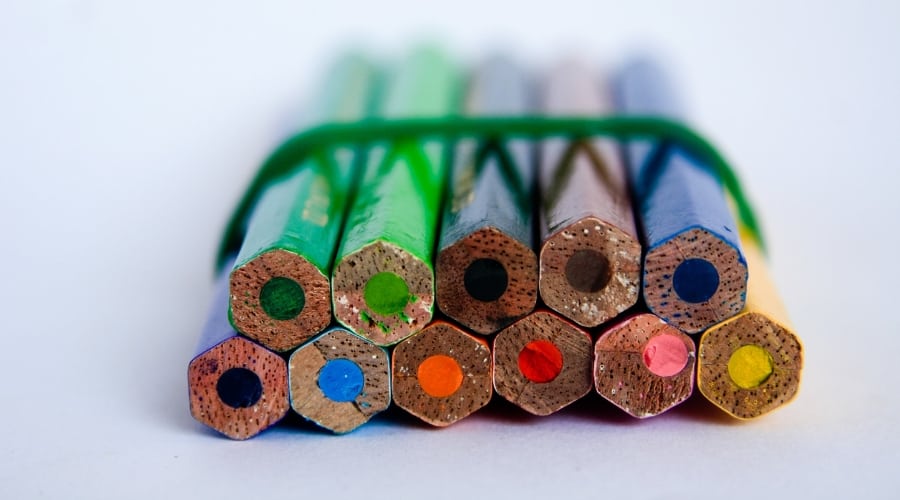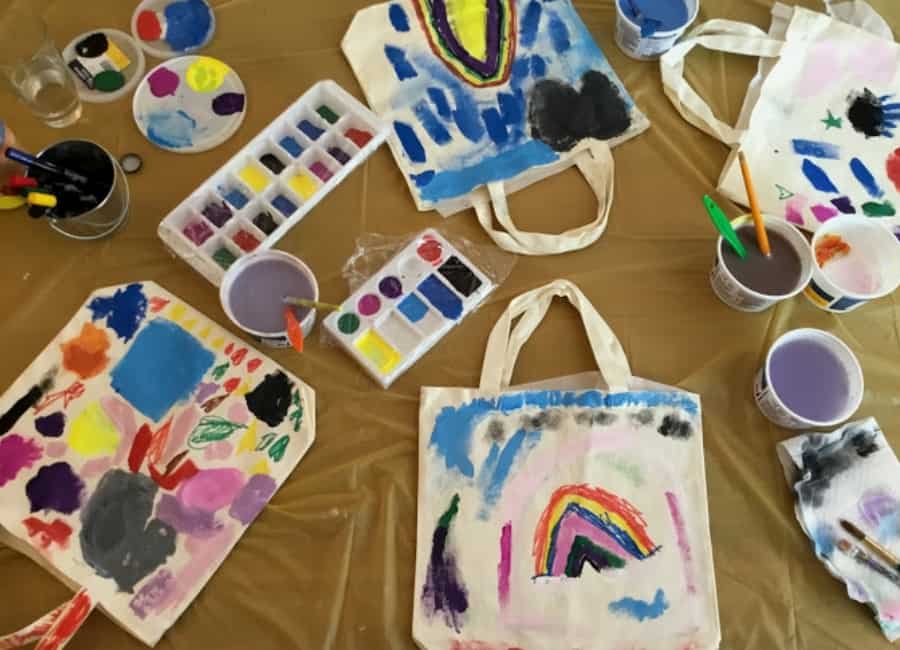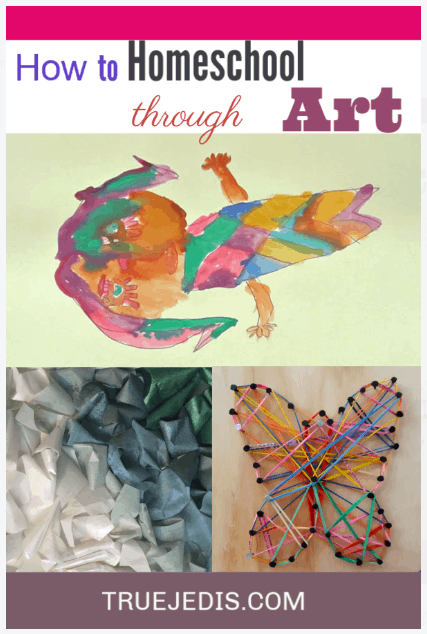
This is a resource that addresses all the questions that you may have about homeschooling and Art. A resource that address how kids can learn art, what they can learn through Art and what art to do at different ages. Most importantly perhaps is the opportunity Art offers to develop learning autonomy that contributes to having confidence in their learning skills and leading their own learning.
1. Art in various disciplines: Math, Building, Science, Food, Culture
2. How to Learn Art History
3. Project Management through Art
4. Art Prompts or Invitations -How it works. Examples
5. Art For the different ages: 5 year olds, 6 year olds, 7-8 year olds, 9-12 year olds
6. What Expectations to Have from Art Class
Art in Math
There are tons of art and craft activities kids may engage in that will require to create a math problem and solve it. But more importantly playing around with patterns, designing patterns, playing with shapes such as making or drawing a room for a doll house, wrapping presents, measuring, estimating distances, drawing an object from life and estimating the angle with your pencil. Drawing one point and two point perspective. As kids get older these activities will become more sophisticated and ambitious and as such will require more accuracy and calculations.
I watched my daughter soon to be 8 years old make a gift bag out of wrapping paper from scratch. She had an idea as to how to make it, but I am sure through the process, she understood every single fold (angle), all the spaces that those angles created and how to manipulate them to create other angles that solved a problem that she created. As she needed to recreate it six times, I think she learned to use similar measurements so all the bags would be about the same size.
My initial instinct was to try to discourage her from trying to make a gift bag because I thought it would take a long time and she would waste a lot of gift wrap in the process and maybe even give up. I am glad I went along with it!
Like Art, Math is a creative process. Like Art, Math requires reflection. Like Math, in Art there are different ways to arrive at the same result.

Art and Building, and Art vs. LEGOs.
We think building is a good play activity for kids because they’ll understand how to make a structure, and how to make it sturdy. On top of that there is a creative element and you may think it is good exposure to engineering, however -at the risk of being the most unpopular homeschool mom- LEGOs in my view is the perfect negation of all that.
Back in the day when LEGOs were just building blocks, (basically another material) that kids could use to let their imagination rampant, solve a problem, design something cool, it was a great toy to build these skills. But nowadays LEGOs are all about following instructions.
I think LEGOs are a great toy to have kids practice attention to detail and practice following instructions. But as for creativity, and exposure to engineering, it is not.
It is very difficult to build a house out of LEGOs. Even if it is just 12”x12”. It is tedious with all the little parts involved, let alone if you wanted to put a roof on it! And unless you have spent a fortune on LEGO pieces, more than likely your child will run out of pieces before he can reach half way up the walls.
Building structures is just part of growing up, and I agree that every kid should have access to that kind of creative activity, but in the realm of Art there are no LEGOs (traditionally), however building is a huge part of art.
The challenge comes in when the structure has to stick together in order to stand. This is accomplished with such supplies as: glue, nail and hammer, tape, staples, wire, push pins. It just depends what kids decide to build with: sticks, plywood, pieces of wood, cardboard, foam board, poster board, popsicle sticks, boxes.
This kind of building not only provides just the right amount of challenge to make it all come together, but it requires a full injection of creativity that can fuel hours of learning.
Playing with mud to make bricks, bird nests, manipulate the dirt and conduct water through mazes, building damns and aqueducts, it’s all possibilities and the decisions are carefully chosen within the context of an idea.
Art in Science
What I like about kids learning to play with art supplies and materials is that it is a colorful, textural and rich sensory way to practice science.
For example: If you provide a 5 year old with baking soda, liquid watercolors, water, vinegar, and soap, they will make all kinds of combinations, some of which might make the mixture bubble up and some combinations will not do any bubbling, but they may end up with a soft and creamy texture. This playfulness in combining the art materials is the scientific method. Different combinations will create a different outcome.
Slime is a perfect example. Kids get so granular about all the different outcomes when they make slime. There may be some fails and some happy accidents. There will be slime that melts, slime that breaks, slime that is stretchy but reaches a certain point when it breaks and there is thin “melty” slime that makes giant bubbles. They experiment by mixing some solid agents like memory foam scraps, fake snow, glitter, etc. They experiment by adding playdough, soap, lotion, other slime, acrylic paint, watercolors… The level of observation and categorizing resembles a Chemistry lab.
Other Art and Science: Making maps, painting countries and oceans. Recreating strata, making models of the Earth’s layers.
If you browse our Free Natural Science Guide for 5 – 8 Year Olds, you will find a number of art related activities.
Cyanotype or Sun Prints
This is an activity that you can do with your kids. It’s really fun to try out different materials and objects to create really cool prints. The process involves different combinations and once kids dip the paper into the water, with a little lemon in it, they are amazed at what happens. At this point you can explain the chemical reactions.
Build a camera oscura and explain the science of how light projects the image on the wall of the camera and if you have a photosensitive paper on that wall, you will have a print of the projected scene.
Art in Food
See our Post Unschooling Cooking-Kids, Play With Your Food! for a creative way to lean to cook, cooking with kids, making cooking fun and developing a love for cooking.
If you are a foodie, encourage you kids to describe what they are eating. Some kids will describe a dish the way an art critic will describe a painting. Whether they like it or they dislike it, ask them why. Ask them to mention something about the texture, the different things they taste, how it can be improved.
Art History

After a talk about Picasso and looking at some of his paintings these 5 year olds were ready to paint like Picasso.
Painting in the style of a famous artist.
Looking at famous paintings and talking about them. The historical context behind Art periods, and paintings is as rich as history itself.
I recommend starting Art History “backwards”, in other words, looking at modern art, studding and discussing artists from modern the 20th and 21st Centuries, and working backwards in time.
In this way you will find that famous artists are a mix of men and women artist. In this way kids start off without developing a bias towards Art belonging to men, which is the sense you get when you learn Art History starting, for example, in the Renaissance.
As you go back in History make sure to still include women into the roaster of important painters.
Kids have a greater affinity these days with Modern Art because they already get a lot of exposure to it through media, museums, travel. It is easy for them to appreciate. Specially if you study what the works are about.
Art in culture and tradition
Día De los Muertos is a perfect example. Not only can you see and experience the rich art in this festival, but you can make so many crafts and painting projects.
See our own turn a smiley face into a skull craft.
Paint sugar skulls
Make ofrenda altars out of little boxes
Make paper tissue flowers
Make headdresses.
All these activities are tied to Mexican tradition.
There is so much art in tradition. Every culture, even the most remote and isolated tribes have specific art and techniques. From the Hopi Kachinas to origami. From the Fallas in Valencia to the tea ceremony. Culture is rich with Art.
Also, there are cultures that are going away, becoming displaced or assimilated by an ever growing western culture. I would start looking up some of these rich in Art tradition because I would venture to say that we will see less and less of this art, perhaps only in certain museums and preserved in history books.
Problem solving, project management through Art.
I remember my first job in project management…I had 0 experience. But I was really trying to scrape something, anything from my past experience that would resemble project management. When I got the job, I realized I should have highlighted my Bachelors in Fine Art as such experience. I realized that the projects I had worked on during my years at the university resembled so closely my projects at work!
Let’s take a look:
Concept development: creating a vision for the product, research.
Pre-production:
Budget forecasting, building a model, pitching the product, getting funding, make tweaks and redefine aspects of the project.
Production: budgeting, finding resources for every part of the project, building a prototype, identifying possible problems, make adjustments, produce, make adjustments, final product.
Granted, my school projects didn’t cost hundreds of thousand of dollars to produce and didn’t require managing cross functional teams. But one thing was exactly the same when I work on my Art projects:
I have to be resourceful, research, adjust, solve, and complete parts of the project in exactly the same way.
Please take a look at The Ultimate Guide to Project-Based Learning for everything from organization, to working with materials, definitions, to project ideas, etc.
Art Prompts or Art Invitations
I used to do this when my daughter was a preschooler. But there is always joy in approaching a set of materials and supplies and creating something, no matter how old you are.
For preschoolers it is a great way to foster creativity and have them play with art without any expectations other than maybe mom buys a little time to sleep in or do some house chores.
It went like this:
My child was always an early riser and I needed to sleep, so the night before I would place PostIts around the house with arrows leading her to the place where I set the Prompt. This idea of the arrows amused her immensely and surprised her every time!
The prompts consisted of a set of materials and supplies that I knew she could make something out of, and that she had never seen together before, and at least one item was new to her, such as:
Prompt: Bar of glue, paper, stapler, a couple of straws, a heart shape cutout.
Prompt: New Stickers, Black paper, crayons, washi tape.
Prompt: Playdough, lids, bright colored PostIts, a box.
Prompt: Blue masking tape, yarn, paper, glitter glue.
There are infinite possibilities…
I learned the following:
1. That I was always going to be pleasantly surprised by what my daughter created with the materials provided. It was totally unexpected to me as I always seemed to envision something completely different. Which put some things in perspective for me.
2. That her favorite materials were tape, and yarn. She went on to always request these two items and I included them in her set of supplies. She run out of tape constantly in the following years due to how many applications it had for her. Still does. We never run out of yarn, but she used it also for so many different applications, even knitting!
3. That she was so excited to find the prompts and had so many questions about the supplies that I was never going to get more sleep.
I continue doing the prompts, sometimes it comes so naturally that I don’t even realize I’m setting up prompts. Sometimes during play dates I would set planting pots, a colander, some dry flowers or herbs , and little clay plates in the backyard. Soon enough the girls would be making something out of this, whether it was cooking or pretend playing or making some potion or planting a garden…
Then indoors, colorful felt pieces would be waiting on the floor, along some popsicle sticks, fabric, markers and glue.
Nowadays I may have my glue gun and foam board on the table. As soon as the girls see the glue gun they’ll have an idea and start looking for the other components or asking me if they can have so and so to make something they have in mind with the glue gun.
Art for 5 year olds
Free drawing is the closest thing to writing when kids are 5 years old. With heir drawings often comes a narrative. There is usually a lot of symbolism, since kids are conscious of their skill they might simplify by adding something that symbolizes what they are wanting to express. There is usually a reason why there are certain elements in the objects or scenes they draw.
Provide them with color pencils, and markers. This makes it easier to express themselves.
If you can, give them tips such as a simple way to draw a chicken, or a bird.
Our daughter was very frustrated with her art skills when she was 5 but one day she came from Art class telling me that if I ever wanted to make a flower out of ModelMagic just make an ball out of clay and and then smaller balls that you would press with your finger on to the bigger ball, until you had a clay flower. He teacher had obviously given her a simple trick that gave her confidence. She was so appreciative!
Don’t expect a 5 year old to draw anything that resembles what they are trying to depict.
Give them water based based paints or pastels. Most kids are only just trying to get better at drawing at this age. Give it time, and encourage them to continue drawing. There is always room for growth in this area.
Modeling with clay is fun. A good intro to modeling is PlayDough and salt dough (homemade). Both materials dry hard and they are excellent for little kids. Salt dough can be painted after it’s dry.
Art for 6 year olds
6 year olds are really into drawing, painting, doing crafts, modeling, anything that involves using their hands. They trust their hand eye coordination. If they have been doing art and crafts since they were little they will revisit the same crafts and materials but now with so much more confidence.
Whereas when they were little they were mostly entrusted with crayons, now you can put away the crayons. It’s hard to get detail with crayons, and are hard to control -the lines are so thick that it’s not easy to be accurate.
6 year olds can produce drawings in better detail. Do encourage them to add more detail to their drawings, suggest something fun, like if she draws a big flower suggest making a trail of ants walking up the stem. If they are drawing a tree, suggest making some leaves and maybe drawing a nest with a baby bird inside.
They may start making faces with noses and eyes with eyelids, etc.
The more kids draw at this age the more they are actually practicing writing. Because the traces they will need to make when they draw letters, specially cursive letters, they already made them a thousand times in their drawings.
Another medium that 6 year olds can enjoy is watercolors. This medium doesn’t require detail, it’s more about the joy of painting. It’s easy to clean and not toxic.
Art for 7 – 8 year olds
At this age kids can do a lot of art: building things, more intricate crafts, their drawing skills are yet getting better, they can use a glue gun, better cutting scissors, many other tools.
They can learn to use clay modeling tools and take a ceramics class. They can understand the process of glazing, and why clay needs to be baked at a certain temperature.
7 and 8 year olds can spend a long time focused on an art project or a drawing. They have very specific ideas about what they want their art to have. They may not be able to sit still for reading or math, but when it comes to art they don’t want to be rushed…they are focused!
Granted, they probably call it a “place for animal families to live and a park” made out of cardboard and play-dough animals, they call it “an island for the pirates to bury treasure” made out of mixed media, they call it “a club house for the Barbies”, they call it a “water park”, they call it a “food safe collection of ceramics”, “a slime factory” and they may, from time to time, call it “Art”.
Please see our recommended supplies.
Art for 9 to 12 year olds
I would encourage kids at this age to try different mediums. Painting with acrylics, pastels, watercolors, pottery, oil painting, collage, photography…
Everyone is different when it comes to art. Some people express a love for leaning art at a young age, but by 9 years old you would notice if they are leaning towards classical arts: they don’t just enjoy drawing, they are hungry to learn techniques, and they spend a lot of their time drawing. There are kids that may lean more towards sculpture or 3D media, or some other kind of media.
I would encourage kids to study the classics, learn history through art history -prehistoric cave paintings, Pompey, Egyptian art, Greek art, Roman art, the renaissance, the baroque, Italian, French, flaming, Spanish…But I would also encourage them to study modern art, to go to modern art museums, to study the history of some contemporary paintings and other disciplines like site specific installations, etc. Please see above section Art History where I describe the advantage of starting with Modern Art.
I would also recommend that they take art classes where they are taught to practice drawing standing up in from of their easels, to draw and paint from life. This is important to gather fluidity, and learn to sketch. In other words, you learn to draw as fast as you think it.
I don’t know any paths of learning richer than art.
What Expectations to Have from Art Class
I find that often parents enroll their kids in Art class because they themselves don’t know anything about art. Which is sensible. And sometimes parents are surprised, taken aback, or disappointed because their expectations aren’t met. They envisioned a course with time spent on learning and practicing technique so their kids can learn to draw the things they want to learn.
Kids art classes nowadays use a mixed approach to teaching kids art. They want the kids to use their own creativity and foster a positive connection with art, to understand that you can make art with anything, to discover and practice different media, to express themselves through art, and to be able to learn certain important parts of making art. They’ll also throw them some tips and tricks and introduce them to different art styles from notable artists.
They will be expected to learn best practices such as cleaning up your brushes, putting the lids on the paint so they don’t dry up, etc.
The older the kids are in the class the more technique the teachers will focus on. At around age 12 if they show a strong aptitude for art, they can often take the same courses as adults, such as oil painting, charcoal drawing, etc. Life Drawing/Painting though possibly the most challenging and enjoyable to artists will not be available until kids are 16 or 18.
With ceramics classes, it’s a little bit more rigid: when they are 6 years old they will be taught basic techniques for modeling, glazing, and a lot of best practices. After they are 8 years old they are introduced to the turning wheel, and learn more about the process of glazing and how to estimate gloss and color. It’s kind of like chemistry.

